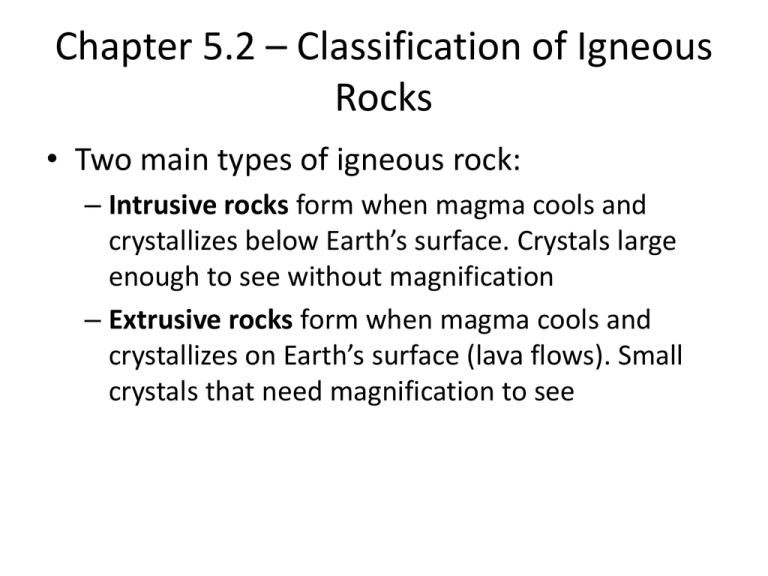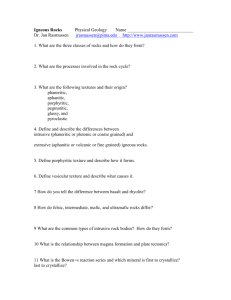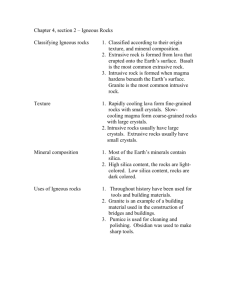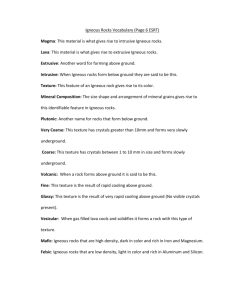Chapter 5.2 * Classification of Igneous Rocks
advertisement

Chapter 5.2 – Classification of Igneous Rocks • Two main types of igneous rock: – Intrusive rocks form when magma cools and crystallizes below Earth’s surface. Crystals large enough to see without magnification – Extrusive rocks form when magma cools and crystallizes on Earth’s surface (lava flows). Small crystals that need magnification to see Types of Classification • Properties – Grain size – Texture – Mineral composition • Basaltic rocks – mafic rocks, dark-colored, low silica contents, and contain mostly plagioclase and pyroxene • Granitic rocks – felsic rocks, light-colored, have high silica content, and contain mostly quartz and feldspar Types of Classification • Intermediate rocks – rocks that have mineral compositions in between the two others • Ultrabasic – ultramafic, contains rocks with only iron-rich minerals and are always dark • Texture refers to size, shape, and distribution of crystals/grains that make up a rock – Examples: fine-grained, coarse-grained Other Properties • When lava cools on the surface, it cools so quickly that only small crystals form – Sometimes crystals don’t form at all – This results in volcanic glass called obsidian Other Properties • When lava cools slowly under the surface, large crystals form – granite, diorite, gabbro Porphyritic Rocks • Porphyritic texture – large, well-formed crystals surrounded by finer-grained crystals of the same mineral or different minerals – Complex cooling history (example: slow cooling then rapid cooling) causes different crystal sizes Vesicular Rocks • Vesicular texture – Spongy appearance formed when gas is prevented from escaping. – The holes left behind are called vesicles – Examples are pumice and vesicular basalt Thin Sections • A Thin Section is a slice of rock 2 x 4 cm and only 0.03 mm thick – Light is able to pass through this sample – These samples are viewed through a petrographic microscope and geologists look for certain properties – Examples of properties: feldspar grains have banding called “twinning,” quartz grains look wavy as stage is rotated, etc. Igneous Rocks as Resources • Useful in many fields such as – Construction – Energy production – Jewelry making • Ores can be extracted from veins of lava flows – Gold, silver, lead, copper – These elements released at end of magma crystallization process Igneous Rocks as Resources • Pegmatites are igneous rocks made of extremely large-grained materials – Found as igneous intrusions or veins • Rare elements such as Lithium, Beryllium form in these ores • They also produce complex crystals Igneous Rocks as Resources • Kimberlites are ultrabasic rocks that were first found in Kimberly, South Africa – Only formed under very high pressure – Valuable minerals such as diamonds • Most diamonds in the world are found in South African mines. Only one diamond mine in the US in Colorado Igneous Rocks as Resources • Igneous rocks are strong building materials – Durable – Weather-resistant – Countertops, floors, statues, etc.








